WGU C172 Network and Security - Foundations
Document Content and Description Below
protocol - ANSWER The set of rules established for users to exchange information topology - ANSWER The network architecture used to interconnect the networking equipment deterministic network - ... ANSWER Each station connected to the network is ensured access for transmission of its messages at regular or fixed time intervals bus topology - ANSWER The computers share the media (coaxial cable) for data transmission ThinNet - ANSWER The coaxial cable used in a bus network. star topology - ANSWER Twisted-pair cables connect the devices to a central hub or switch hub - ANSWER A multiport repeater device used at the center of a star topology multiport repeater - ANSWER The data it receives is broadcast and seen by all devices connected to its ports. A hub. broadcast - ANSWER Transmission of data by a hub to all devices connected to its ports switch - ANSWER Device used at the center of a star topology that forwards a frame it receives directly out the port associated with its destination address mesh topology - ANSWER All networking devices are directly connected to each other, allows for full redundancy OSI model - ANSWER The seven layers describing network functions Physical layer - ANSWER Provides the electrical and mechanical connection to the network (cabling, NICs). 1st OSI layer Data link layer - ANSWER Handles error recovery, flow control (synchronization), and sequencing (MAC, Ethernet). 2nd OSI layer Network layer - ANSWER Accepts outgoing messages and combines messages or segments into packets, adding a header that includes routing information (IP, IPX). 3rd OSI layer Transport layer - ANSWER Concerned with message integrity between source and destination (TCP, UDP). 4th OSI layer Session layer - ANSWER Provides the control functions necessary to establish, manage, and terminate the connections (NSF, SQL). 5th OSI layer Presentation layer - ANSWER Accepts and structures the messages for the application (ASCII, JPEG). 6th OSI layer Application layer - ANSWER Interacts with application programs that incorporate a communication component such as your Internet browser and email (HTTP, FTP, SMTP). 7th OSI layer 3 basic steps to isolate network problem - ANSWER Is the connection to the machine down? (layer 1) Is the network down? (layer 3) Is a service on a specific machine down? (layer 7) CSMA/CD - ANSWER The Ethernet LAN media-access method, carrier sense multiple access with collision detection Ethernet - ANSWER LAN protocol created in 1972 and standardized in 1980 using CSMA/CD. Frame - ANSWER Contains the header, data, and trailer (the padding and 4-byte CRC frame check sequence) Frame header - ANSWER Consists of the preamble, start frame delimiter, destination and source addresses, and length/type field 64 bytes - ANSWER Minimum length of an Ethernet frame 1518 bytes - ANSWER Maximum length of an Ethernet frame MAC address - ANSWER A unique 6-byte/48-bit address assigned by the vendor of the network interface card displayed in 12 hex digits Organizationally unique identifier (OUI) - ANSWER The first 3 bytes of the MAC address that identifies the manufacturer of the network hardware ipconfig /all - ANSWER Enables the MAC address information to be displayed from the command prompt IANA - ANSWER The agency that assigns IP addresses to computer networks IP address - ANSWER Unique 32-bit address that identifies on which network the computer is located as well as differentiates the computer from all other devices on the same network Class A networks - ANSWER Governments, very large networks. Range from 0.0.0.0 to 126.255.255.255. Example: 44.x.x.x Class B networks - ANSWER Midsize companies, universities, and so on. Range from 128.0.0.0 to 191.255.255.255. Example: 128.123.x.x Class C networks - ANSWER Small networks. Range from 192.0.0.0 to 223.255.255.255 Example: 192.168.1.x Class D networks - ANSWER Reserved for multicast groups. Range from 224.0.0.0 to 239.255.255.255. Example: 224.x.x.x Class E networks - ANSWER Experimental, not used on the Internet. Range from 240.0.0.0 to 254.255.255.255 Network number - ANSWER The portion of the IP address that defines which network the IP packet is originating from or being delivered to Host number - ANSWER The portion of the IP address that defines the location of the networking device connected to the network; also called the host address Host address - ANSWER Another name for the host number ipconfig - ANSWER Command used to display the computer's address Private addresses - ANSWER IP addresses set aside for use in private intranets Intranet - ANSWER An internal network that provides file and resource sharing but is not accessed from the Internet IP internetwork - ANSWER A network that uses IP addressing for identifying devices connected to the network 3 blocks for private IP addresses - ANSWER 10.0.0.0-10.255.255.255 172.16.0.0-172.31.255.255 192.168.0.0-192.168.255.255 Wired network - ANSWER Uses cables and connectors to establish the network connection Wireless network - ANSWER Uses radio signals to establish the network connection Wi-Fi - ANSWER Wi-Fi Alliance—an organization that tests and certifies wireless equipment for compliance with the 802.11x standards 802.11a - ANSWER Wireless standard, 54Mbps, 75 ft, 5Ghz 802.11b - ANSWER Wireless standard, 11Mbps, 100-150 ft, 2.4GHz 802.11g - ANSWER Wireless standard, 54Mbps, 150 ft, 2.4GHz 802.11n - ANSWER Wireless standard, 4 x 802.11g speeds (200+Mbps). 2.4GHz or 5GHz 802.11ac - ANSWER Latest wireless standard, single-station data transfer rates of 500Mbps, 5Ghz wireless router - ANSWER Device used to interconnect wireless networking devices and to give access to wired devices and establish the broadband Internet connection to the ISP access point - ANSWER A transceiver used to interconnect a wireless and a wired LAN Broadband gateway - ANSWER Combines a modem and router in one unit. Also referred to as a broadband modem range extender - ANSWER Device that relays the wireless signals from an access point or wireless router into areas with a weak signal/no signal hotspots - ANSWER A limited geographic area that provides wireless access for the public Service Set Identifier (SSID) - ANSWER Wireless network name Wi-fi Protected Setup (WPS) - ANSWER Simplifies Wi-Fi configuration but vulnerable to brute force attacks Stateful Packet Inspection (SPI) - ANSWER Firewall technique that inspects incoming data packets to make sure they correspond to an outgoing request Virtual Private Network (VPN) - ANSWER Establishes a secure network connection, a way to protect your LAN's data from being observed by outsiders Overloading - ANSWER Technique where NAT translates the home network's private IP addresses to a single public IP address Port Address Translation (PAT) - ANSWER A port number is tracked with the client computer's private address when translating to a public address CAT6 - ANSWER Class E twisted-pair cables capable of up to 1000Mbps/1Gbps up to a length of 100 m RJ-45 - ANSWER The 8-pin modular connector used with CAT6/5e/5 cable Numerics - ANSWER A numerical representation (used to describe the data rates for the twisted-pair/coaxial media) 10Base2 - ANSWER ThinNet. 10Mbps over coax, up to 185 m 10Base5 - ANSWER ThickNet. 10Mbps over coax, up to 500 m 10BaseT - ANSWER 10Mbps over twisted-pair 10BaseF - ANSWER 10Mbps over multimode fiber-optic cable 10BaseFL - ANSWER 10Mbps over 850 nm multimode fiber-optic cable 100BaseT - ANSWER Fast Ethernet. 100Mbps over twisted-pair 100BaseFX - ANSWER 100Mbps over fiber 1000BaseT - ANSWER Gigabit Ethernet. 1000Mbps over twisted-pair 1000BaseFX - ANSWER 1000Mbps over fiber 10GE - ANSWER 10Gb Ethernet 10GBaseT - ANSWER Another name for 10GE when over copper Straight-through - ANSWER Transmit and receive signal pairs are aligned end-to-end Crossover - ANSWER Transmit and receive signal pairs are switched Uplink port - ANSWER Allows the connection of a switch to another switch without having to use a crossover cable Link light - ANSWER Indicates that the transmit and receive pairs are properly aligned Link integrity test - ANSWER Protocol that verifies a communication link between two Ethernet devices has been established Link pulses - ANSWER Sent by connected devices via twisted-pair when data is not being transmitted to indicate that the link is still up Ping - ANSWER ICMP command used to test that a device on the network is reachable Internet Control Message Protocol - ANSWER What ICMP stands for, verifies that messages are being delivered Open system interconnect - ANSWER What OSI stands for TIA/EIA 568-A - ANSWER The first major standard describing a structured cabling system for computer networks in 1995 campus area network (CAN) - ANSWER Interconnected LANs within a limited geographic area (college campus, military base, group of commercial buildings) EIA/TIA 568-B - ANSWER The standard that defines the six subsytems of a structured cabling system. EIA/TIA-568-B.1 - ANSWER Commercial cabling standard, master document EIA/TIA-568-B.2 - ANSWER Standard for twisted-pair media EIA/TIA-568-B.3 - ANSWER Optical fiber cabling standard Building entrance - ANSWER The point where the external cabling and wireless services interconnect with the internal building cabling. Also called the entrance facilities. Entrance facilities (EF) - ANSWER Another name for the building entrance Equipment room (ER) - ANSWER A room set aside for complex electronic equipment such as the network servers and telephone equipment Telecommunications closet - ANSWER The location of the cabling termination points that includes the mechanical terminations and the distribution frames. Also called telecommunications room (TR) or telecommunications enclosure (TE). Backbone cabling - ANSWER Cabling that interconnects telecommunication closets, equipment rooms, and cabling entrances in the same building and between buildings Horizontal cabling - ANSWER Cabling that extend [Show More]
Last updated: 2 years ago
Preview 1 out of 28 pages

Buy this document to get the full access instantly
Instant Download Access after purchase
Buy NowInstant download
We Accept:

Reviews( 0 )
$10.00
Can't find what you want? Try our AI powered Search
Document information
Connected school, study & course
About the document
Uploaded On
Sep 10, 2022
Number of pages
28
Written in
Additional information
This document has been written for:
Uploaded
Sep 10, 2022
Downloads
0
Views
76



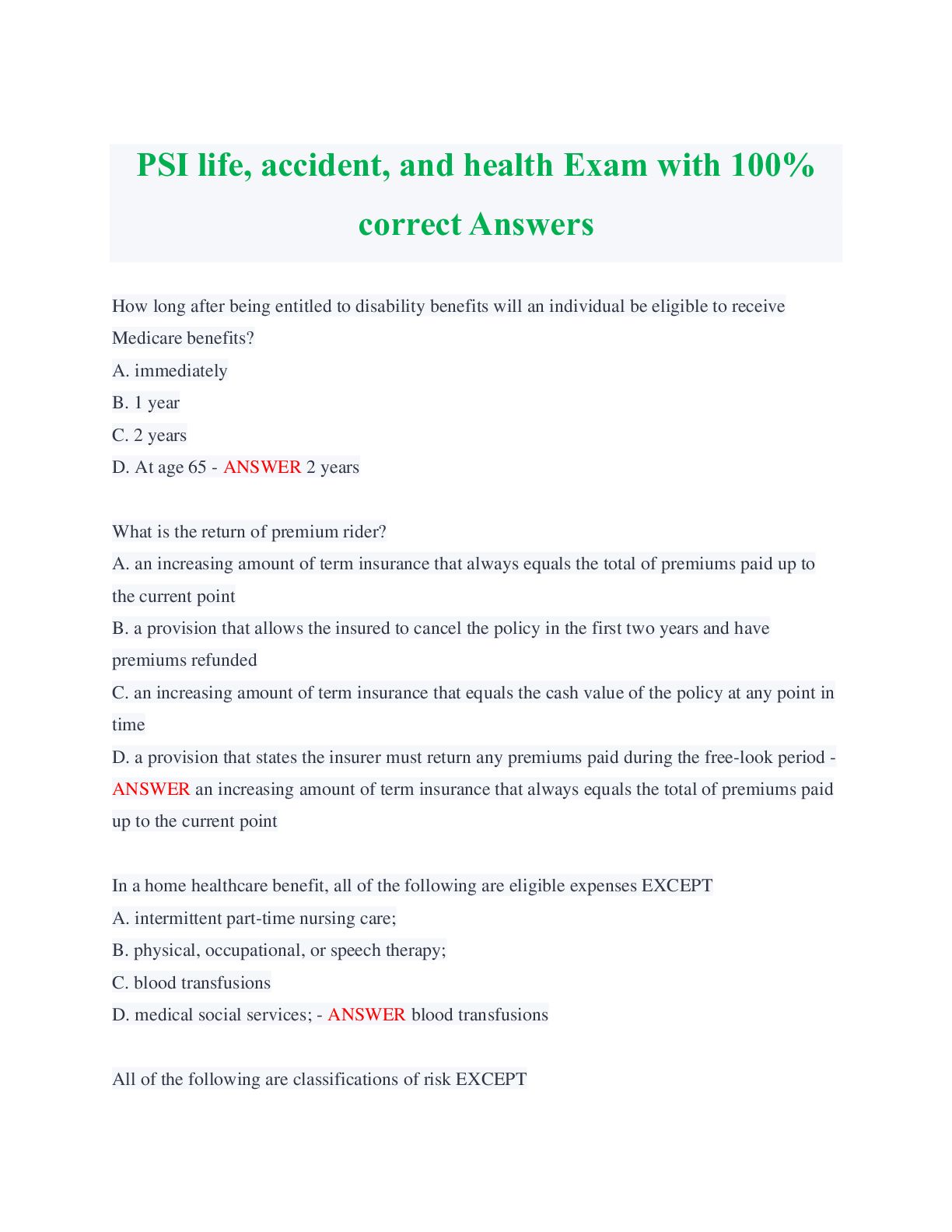









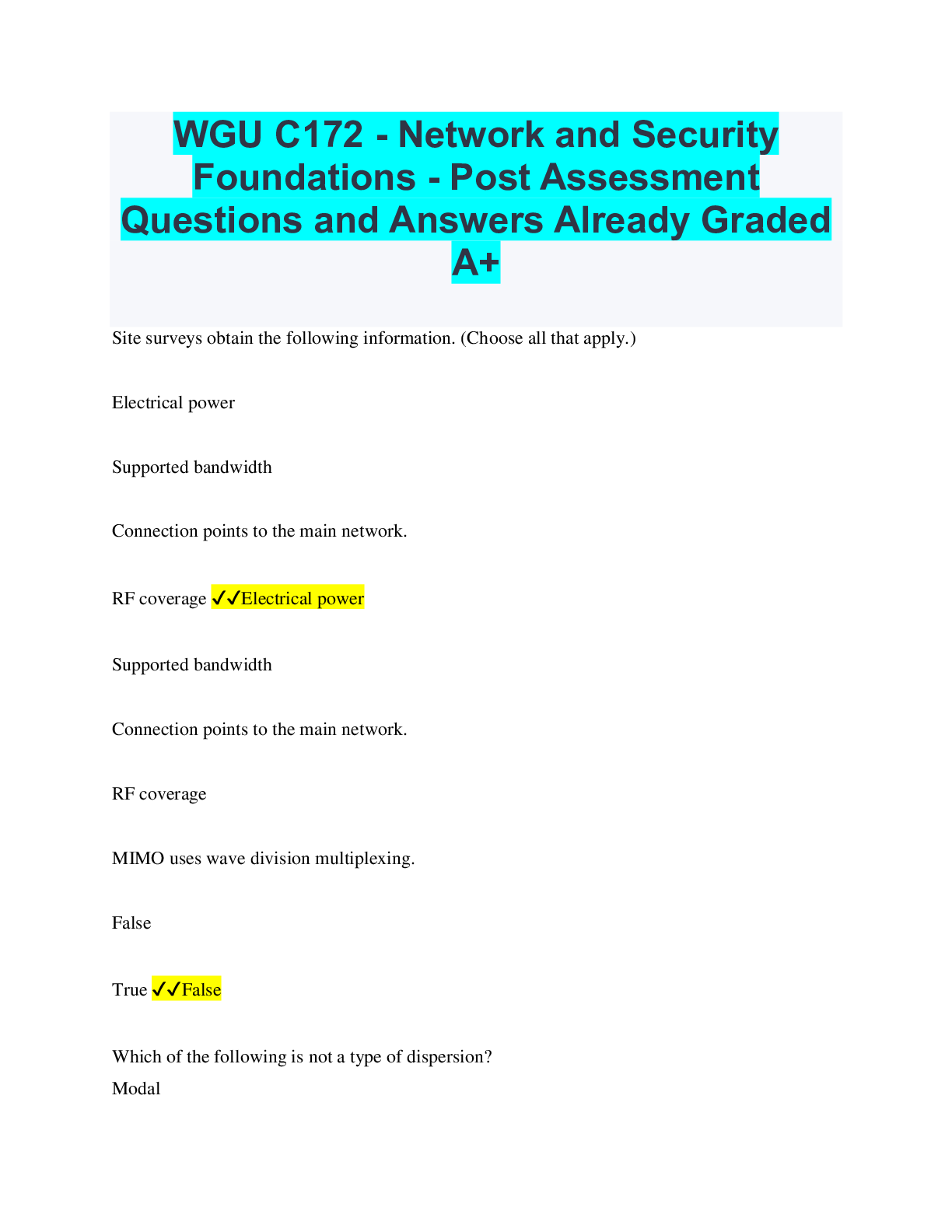
.png)

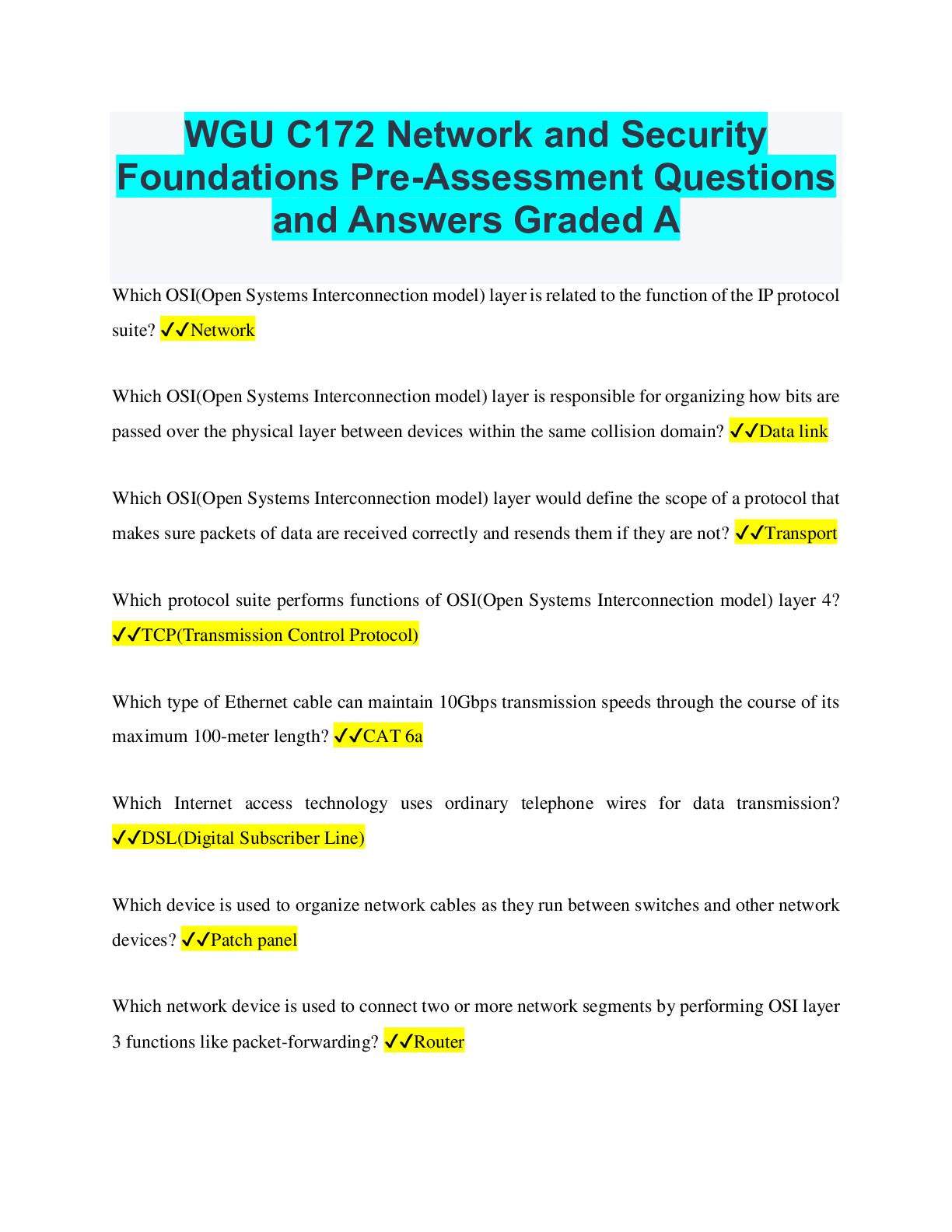
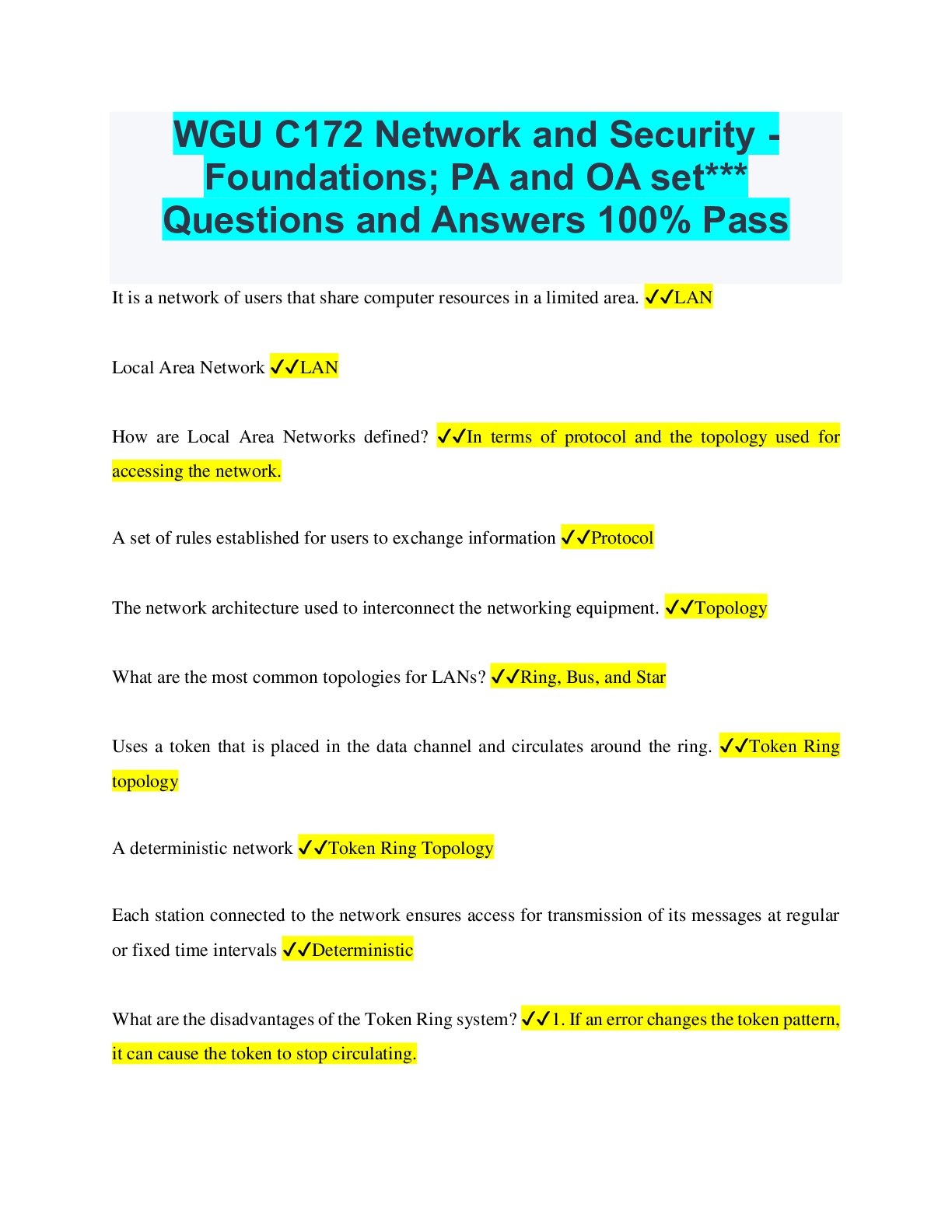



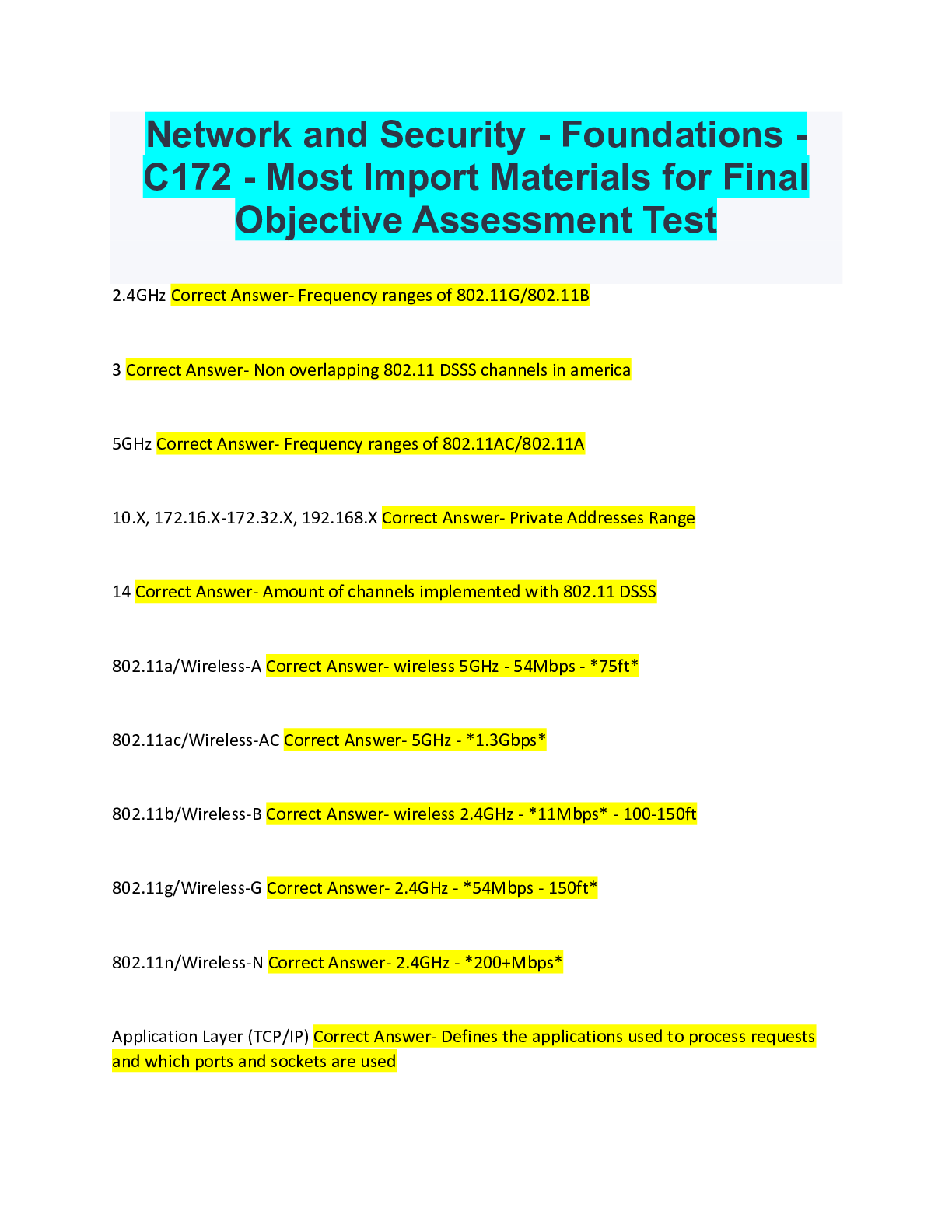
.png)

